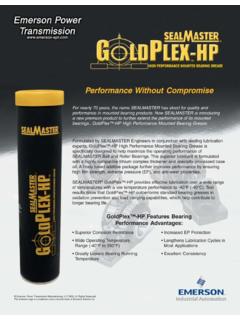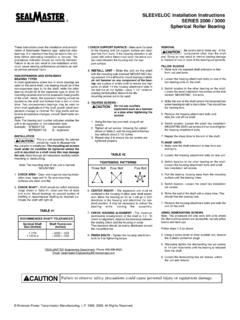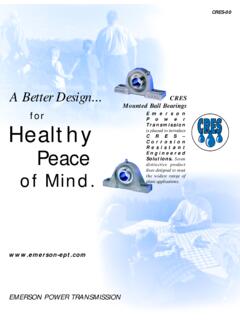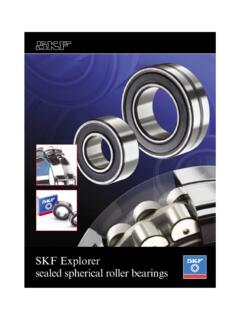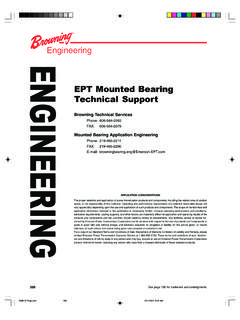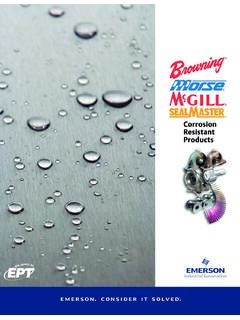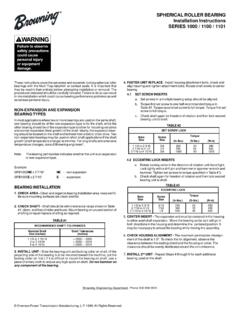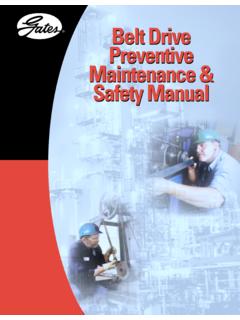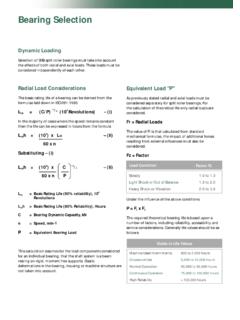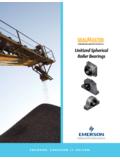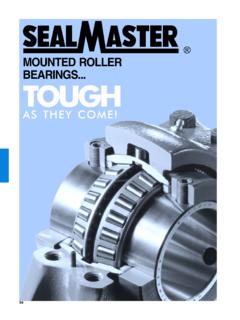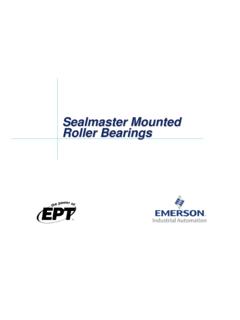Transcription of Sealmaster Mounted Bearing Engineering Guide
1 Application Parameters:Shaft Speed in RPM:Desired Operating Life in Hours: Bearing Loads in Lbs.:Environments:WetRadial:ChemicalThru st:DirtyOtherOperating Temperature:-30 to 200 F *200 to 400 F-100 to -30 F * Bearing Type and Bore:Check Ball and roller Bearing Pages Bore Size: Bearing Housing Page Seal Pages Selected:Felt SealContact Lock Pages Lock Selected:Single Lock Set ScrewDouble Lock Set ScrewSkwezloc (Ball Bearings Only)BEARINGSELECTIONGUIDE6. Refer to .. Pages 10-13 For Ball Bearing Nomenclature and Pictorial index to locate to .. Pages 96-97 For roller Bearing Nomenclature and Pictorial index to locate Selected:7. For Application Parameters outside capabilities of selected *Contact Application Engineering (630-898-9620) or you can fax theApplication Worksheet on Page 207 to (630-898-6064).
2 For Ordering Contact Customer Service (800-354-9820) 177 TABLE OF CONTENTSBall Bearing Selection ..Pages 178-181 Tapered roller Bearing Selection ..Pages 182-183 Sample Calculations ..Pages 184-186 Housing Selection ..Pages 187 Seal Selection ..Pages 188-189 Lock Selection ..Pages 190-191 Bearing Basics ..Pages 192-193 Vibration Bearings ..Page 194 roller Bearings ..Page 195 Lubrication ..Page 196 Recommendations ..Page 197 Fittings ..Page Mounting Procedures ..Page 200 RPB Taper roller Bearing and Replacement ..Page 203 Recommended Shaft Tolerances ..Page 204 High Speed- High Load Applications ..Page 204 Set Screw and Capscrew Information ..Page 205ER, SC, and ERCI Housing Recommendations .Page 206 Application Worksheet.
3 Page 207 Refer to Application Section ..Pages 128-143to review a variety of Operational Conditions178 BALL Bearing RATING & SELECTIONB earing Life CalculationWhile both Ball and roller bearings may be considered as possibledesigns on a given application, the formulas and calculations are differentand will be treated separately. Typically, Ball bearings are usuallyspecified on applications with lighter loads but have a higher speedcapacity. As Ball bearings usually cost less for a given shaft size theyare considered first. If the desired life or load capacity cannot be achievedwith a ball Bearing then a tapered roller Bearing should be considered(see page 182 for Tapered roller Bearing life calculations). Bearing SYMBOLS FOR LIFE CALCULATIONC - Basic Dynamic Rating (lbs)C0- Static Rating (lbs)P - Equivalent Radial Load (lbs)n - Speed (RPM)L10 - Rated Life (Hours)K - Geometry FactorLna- Adjusted Rated LifeX - Radial FactorFa- Applied Thrust Load (lbs)Y - Thrust FactorFr- Applied Radial Load (lbs)e - Geometry RatioBall Bearing Life CalculationThe following formula provided by the Anti Friction BearingManufacturers Association (ABMA) provide a method for calculatingestimated fatigue life of Ball Bearings.
4 L10 = (C/P)3x 16667nWhere:L10 = The number of hours that 90% of a group of identical bearingsunder ideal conditions will operate at a specific speed and load conditionbefore fatigue failure is expected to = The Basic Dynamic Load Rating in = The equivalent Radial Load in = Shaft speed in , the ABMA provides application factors for Ball Bearingswhich need to be considered to determine an adjusted Rated Life (Lna).Lna = a1 x a2 x a3 x L10 Where:Lna = Adjusted Rated = Reliability factor applied where estimated fatigue life is based onreliability other than 90% (See Table No 1).Table No. 1 Life Adjustment Factor for ReliabilityTable No. 2 Shock/Vibration FactorThe a3 factor takes into account a wide range of application andmounting conditions as well as Bearing features and design.
5 Accuratedetermination of this factor is normally achieved through testing andin-field experience. Sealmaster offers a wide range of options whichcan maximize Bearing performance. Consult SEALMASTERA pplication Engineering for more information. *See samplecalculations on page an initial Bearing size and calculate the expected L10 life. Ifthe life is not acceptable, select another Bearing size as appropriateand recalculate the Lna life. Continue this iterative process until anappropriate Lna life is Load CalculationFor applications where combined radial and thrust loads are presentthe equivalent radial load (P) must be calculated before applying theL10 life For applications with only a radial load present P = FrWhere Fr = Applied radial load in For applications with only a thrust load presentContact Sealmaster Application = Material adjustment for Bearing race material.
6 All Sealmaster Ball bearingraces are manufactured from 52100 Vacuum Degassed Bearing the a2 factor is for all Sealmaster Ball Bearings. It isimportant to check with all manufacturers to ensure that properadjustments are made when other Bearing steels are = Life Adjustment Factor for Operating factor should take into account the adequacy of lubricant, presenceof foreign matter, conditions causing changes in material properties,and unusual loading or mounting conditions. Assuming a properlyselected Bearing having adequate seals and lubricant operating below250 F and tight fitted to the shaft, the a3 factor should be ball bearings are typically slip fitted to the shaft and rely ondesign features such as the inner race length and locking device forsupport.
7 ABMA recommends an a3 factor of .456 for slip fit ballbearings.*Shock and Vibration* Vibration and shock loading can act as anadditional loading to the steady expected applied load. When shockor vibration is present, the following a3, Life Adjustment Factors arerecommended. The shock factor is used in combination with the slipfit (P) equivalent radial Use Table 4 to identify the relative axial load factor (ND2).2. Determine the relative axial load (RAL):RAL =Fa-applied thrust loadND2-relative axial load factor3. Match the nearest relative axial load value in Table #3 to thecorresponding e value. For precise calculation, linearly interpolatethe values for e for your exact relative axial load Calculate Fa/Fr and compare value to the e value found in step#3 Choose values for X and Y based on step #3 & 4 and fromTable No.
8 3. Linear interpolation is recommended for Calculate equivalent radial load using the following equation:P = XFr + YFa7. Calculate the adjusted life (Lna) using the life calculation to Page 182 for Relevant Bearing RATING & SELECTIONT able No. 4 Load Ratings - Ball BearingsTable No. 3 Equivalent Load CalculationData - Ball Bearings1. For standard and medium duty spherical outerrace inserts as well as AR bearings, match thebearing insert number to the insert number onthe ratings chart ( 2-15, AR-2-15, 2-15D, and2-15T all use 2-15 insert rating.)2. For ER , RB and TXP inserts, match bearinginsert number to ER number ( ER-23 &TXP 23 both use an ER-23 insert rating.)Contact Sealmaster Engineering for of Rating Selection:Ball Bearing Selection -New Applications:Using variations of the life formulasand application information, it ispossible to select bearings basedon desired life, load applied, andshaft speed.
9 This method can beapplied where axial load is lessthan or equal to 1/2 the Determine required applicationhours (Lna).2. Calculate L10 using adjustmentfactors:L10 =Lnaaf x a2 x a33. Calculate Basic Dynamic RadialRating (Creq).4. Use Table No. 4, find a basicDynamic Radial Rating Valuegreater than or equal to Creqcalculated in step # Select any Bearing from the rowin step # 4 or larger. If Creq isgreater than the largest BasicDynamic Radial Rating Value ofTable No. 4, go to roller BearingSelection on page If Ball Bearing is selected,proceed with housing, seal, lockselection pages operating temperaturerange for standard bearings is -20 to 200 F. For operatingtemperatures outside this rangecontact application Maximum speed information,see tables on pages 180 and = P x( L10 x N )1/3 16,667 YTUDDRADNATSYTUDMUIDEMCISABCIMANYDLAIDAR GNITARCITATSLAIDARGNITAREVITALERLAIXADAO LROTCAF2^DNTSURHTGNITARTFAHSEZIS#TRESNI# RETFAHSEZIS#TRESNI2/161/98/561/114/3mm02 80-290-2010-2110-2210-240258-BR/RE9-RE01 -BR/RE11-RE21-BR/RE402- ee> BALL Bearing RATING TABLESThis chart displays the Goldline Ball Bearing load capacities for a given L10 life, speed, and shaft size.
10 The shaded area indicates themaximum speed ratings for SKWEZLOC and double lock bearings (applicable on sizes available). All speeds listed are for the standard feltseal. See Seal Selection for alternate seals, pages in the table represent loads at ideal conditions with press fit mounting to the shaft. ABMA recommends de-rating of slip fit mountedbearings. To obtain de-rated load, divide the load in the table by Values in the table represent equivalent radial loads only. For combinedload determination, see page 178. Areas designated by - exceed maximum value for standard bearings. Consult Sealmaster ApplicationEngineering for load and speed applications not covered in this Lock and SKWEZLOC use same Bearing insert ratings as single lock inserts shown RB, TX, and ETX inserts use standard duty load ratings for the appropriate shaft Bearing RATING TABLEST able No.
